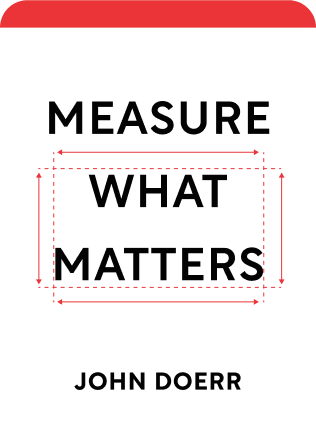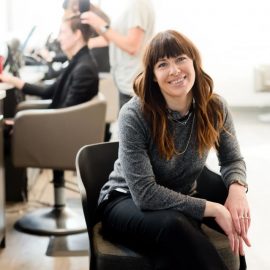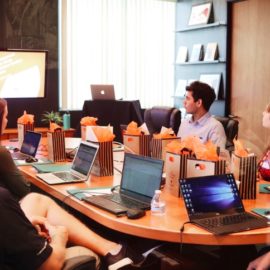

This article is an excerpt from the Shortform summary of "Measure What Matters" by John Doerr. Shortform has the world's best summaries of books you should be reading.
Like this article? Sign up for a free trial here .
What are OKR stretch goals? What is the purpose of stretch goals, and how can they work for you?
OKR stretch goals are used to help you establish your most ambitious goals. OKR stretch goals are important because they help you prioritize and focus, and give your team something to work towards.
Keep reading to find out more about OKRs.
Choosing Your OKR Stretch Goals
How to Implement OKRs for stretching: Some of your OKRs should be especially challenging. Expect “stretch OKRs” to score between 0.4 and 0.6. Setting challenging goals allows your company to continue innovating.
Google and OKR Stretch Goals
This is how Google distinguishes between regular objectives (“committed objectives”) and stretch objectives (“aspirational objectives”):
- Committed objectives are the goals that need to be met within a set period of time for the company to prosper. Additionally, these goals need to be 100% or near-100% complete (or receive a score of 1.0) by the deadline. Committed objectives include sales and revenue goals around product releases, customer satisfaction, and hiring.
- Aspirational objectives are goals that reflect the bigger picture, outside of day-to-day needs, and focus on big, ambitious ideas. These are often called OKR stretch goals or, in the words of Jim Collins, “Big Hairy Audacious Goals.” (Shortform note: For more on Big Hairy Audacious Goals, read our summary of Collins’s Good to Great.)
Google doesn’t expect everyone to achieve their aspirational objectives, and failure is built into the process—in fact, the average rate of failure at Google is about 40%. In other words, Google considers its cycle’s aspirational goals a success if 60% of them are achieved.
Not many companies have Google’s resources, and therefore can’t risk a failure rate that high. Your company’s balance of committed and aspirational objectives will depend on your answers to the following questions:
- Do we want to break into a new market next year? (If yes, favor aspirational objectives, or OKR stretch goals.)
- Do we want to further establish our current position in the market? (If yes, favor committed goals.)
- Do we have some extra cash to play around with? Can we afford to make a risky bet? (If yes, favor stretch goals.)
- Are we in survival mode, just trying to stay afloat? (If yes, favor committed goals.)
- What does our business need from us, right at this moment?
Regardless of your answers, every company should have at least one or two aspirational objectives. If your company doesn’t stretch, it won’t be able to compete in the market.
Researcher Edwin Locke has found that, generally, the more challenging a goal is to achieve, the higher people perform trying to reach it. In Locke’s study, even though subjects with challenging goals failed more often than subjects with easy goals, the subjects with the hard goals performed at a higher level and achieved more overall. This shows that stretch objectives are valuable regardless of whether or not people achieve them, because they inspire employees to work harder.
Tips for Creating Stretch Goals
What not to do:
- Don’t impose stretch goals on your employees without being aware of the realities of their day-to-day work.
- Don’t stretch your team too far, especially employees who are used to achieving 100% on their OKRs. For high achievers, achieving less than 100%, even if it’s expected, can negatively influence morale.
- Don’t set goals that are clearly impossible to achieve. There’s a fine line between aspirational and unrealistic. Aspirational goals inspire employees; unrealistic goals hurt morale.
- Don’t work toward stretch objectives with incremental OKRs. OKRs should be exponential, rather than incremental—aim for 300% improvement, not 10%.
What to do:
- Distinguish between committed objectives, goals that must be completed 100% in a certain period of time, and aspirational objectives.
- Convey to employees why the outcome of the stretch goal is important.
- Convey to employees that you believe the stretch goal is attainable.
- Ask: How can our team create the most value possible? What would incredible look like for our company?
Example: YouTube
YouTube’s growth demonstrates both the power of OKR stretch goals and the necessity of figuring out the right metrics—in other words, learning out how to measure what matters. Identifying the right metrics helps ensure your stretch objectives matter.
Metrics of Success
By 2011, YouTube knew how to make money, but the team didn’t know how to increase viewership. This prompted them to ask, “Which is more important? Money or viewership? Should we measure success by dollars or viewers?”
In contemplating these questions, the team realized that what really mattered was how much time people spent watching videos on YouTube. Consequently, they abandoned the old ways of defining success: number of clicks, number of views, and revenue amount. Instead, they focused on one thing, and one thing only: increasing the number of hours people spent watching YouTube videos.
YouTube’s Stretch Goal
In 2012, leader Shishir Mehrotra set a hugely aspirational goal: “one billion hours in daily user watch time” by the end of 2016. This was a 10x increase in hours, and the number was largely arbitrary, chosen because it was simple and inspiring.
Framing a stretch goal to make it seem manageable and possible is key to achieving it. Mehrotra pointed out that although one billion hours of watch time a day was a huge goal, it still represented less than 20% of the total number of hours people spent watching television every day.
Although they were driven toward their goal, they weren’t “10x absolutists.” They made a few sacrifices of watch time in order to provide viewers with better-quality content. But even though the team occasionally made decisions that hurt watch time in the short term, they never made a decision without meticulously calculating how it would affect watch time and considering if it was worth the cost.
By 2016, with the end-of-the-year deadline looming, the team made 150 incremental changes that each made a mere 0.2% impact on watch time. But those 0.2% changes added up. By October, YouTube hit the billion-daily-hours mark, two months ahead of schedule.
Redefining Success, Again
What you measure matters, but that doesn’t mean a metric that mattered last year will still matter next year. You need to change your metrics as your business and the environment change, and you need to stretch in new directions.
Watch time was the right metric for YouTube in 2016. Today, YouTube is more focused on social responsibility, and their new metric is not watch time, but user satisfaction. To this end, they measure the “likes” and “dislikes” of videos in order to recommend quality content to each user, and in 2017 they added a “breaking news shelf” to the homepage to spread information from authoritative news sources.
Now that you know all about OKR stretch goals, you can start developing your own goals for your team.

———End of Preview———
Like what you just read? Read the rest of the world's best summary of John Doerr's "Measure What Matters" at Shortform .
Here's what you'll find in our full Measure What Matters summary :
- How Google uses OKRs to rally 100,000 employees in the right direction
- How to avoid setting useless OKRs, and how to set great ones
- Key subtle behaviors your team must master to make OKRs work






